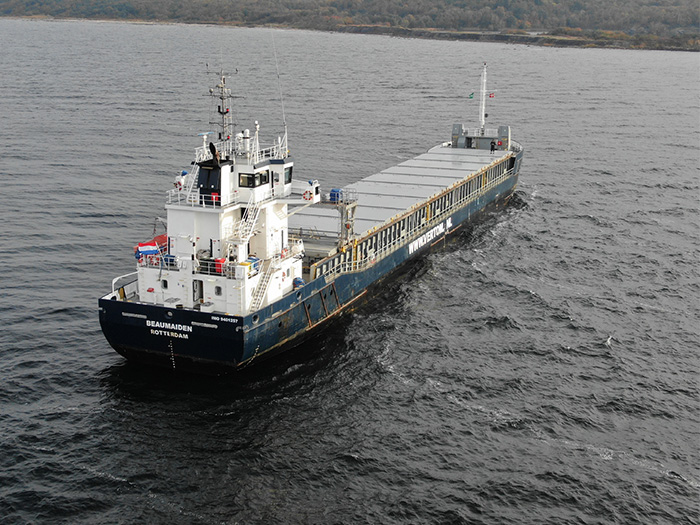
And when the master woke up, the ship had grounded
Written by Nick Blenkey
Beaumaiden agrounf [Image; DMAIB]
You can’t make this stuff up. A recent Danish Marine Accident Investigation Bureau report into the October 18, 2021, grounding of the 88.6 meter long Dutch registered general cargo ship Beaumaiden near Sorthat Odde, Bornholm, Denmark, is worth reading in full.
Basically, the master, who was the sole watchkeeper, had been drinking wine. When he needed to use the toilet, because the one on the bridge didn’t flush properly, he went below to use the toilet in his cabin three decks down. He fell asleep there until some four hours later, when he was woken by the chief engineer following the grounding.
The accident investigation report notes that the ship had a crew of seven of various nationalities: Three navigational officers, including the master, one engineer and three ratings of whom one was the ship’s cook.
It had departed Antwerp on October 15, loaded with 3,000 tons of fertilizer and headed for Tallin, Estonia. It exited the Kiel Canal on October 17 at 10.00 a.m. and the pilot disembarked shortly after. The ship proceeded eastwards in Femern Belt en route to Tallin under the master]s command.
The DMAIB report continues:
“At noon time, the master was relieved on the navigational bridge by the 3rd officer. After the handover, he went to his cabin, watched a movie and took a nap. He woke up at 1700 and went to the messroom to have dinner. Afterwards he went to his cabin to watch a movie while he drank a glass of wine.
Just before 2000 the master went to the bridge to relieve the chief officer. They had a short conversation, and the watch was handed over. The chief officer did not notice anything unusual about the master nor did he notice that the master had been drinking wine. By now, it was dark, and the master was alone on the bridge, because it was not common practice to have an able seaman (AB) on duty during night-time to keep lookout.
“The ship proceeded in Kadetrenden on course 062°, and the next course change was to be made near Bornholm 4-5 hours later. There was little traffic, and the weather was good. During the watch the master sat in the navigational chair and made several phone calls to friends while he listened to music.
AFTER A WHILE, HE WENT TO HIS CABTN TO FETCH HIS WINE GLASS …
“After a while he went to his cabin to fetch his wine glass. He filled it with wine and brought it to the bridge. The ship kept a steady course and speed, and there was no oncoming or crossing traffic for the master to take into consideration.
“A few hours into the watch, the master had to go to the lavatory, but he knew that the toilet on the bridge did not flush properly, so he had to use the toilet in his cabin. After having made a phone call to a friend at home where nobody answered, he went to his cabin three decks below. Whilst in his cabin he felt tired and laid down on the bed to rest. He then fell asleep.
“At 2.55 a.m., MAS Denmark contacted Maritime Operations Center (MOC) and requested them to scramble a rescue vessel to intercept Beaumaiden, because it was on a course head- ing directly towards the shores of Bornholm. In the following minutes, via the coastal radio station Lyngby Radio (LYRA), MAS Denmark tried to contact the ship by VHF, VHF DSC and by phone without getting any response from the ship. The Danish Police on Bornholm was contacted and advised that Beaumaiden was about to run aground on Bornholm.
“On Beaumaiden the chief engineer was asleep in his cabin when he was suddenly awoken by the ship violently vibrating. He hurried out of his cabin and out on the aft deck where he saw the wake from the propeller. It was dark outside, and he noticed that the bearing to the lights from shore was not changing which indicated that the ship was stopped. Straightaway he realized that the ship had run aground. The time was 0325.
“From the aft deck he went into the accommodation and ran up the stairs to the navigational bridge. When he opened the door to the bridge, he heard loud music, noise from numerous alarms and found the bridge empty. He rushed to the conning station and put the propeller pitch to zero, but he did not know how to silence the alerts from the various instrumentation, or how to stop the music. He then went downstairs and woke up the chief officer and informed him about the situation. The chief engineer told the chief officer to go to the bow thruster room to check if there was any water ingress. Meanwhile he went to the engine room to check for water ingress and switch from power supply from the main engine shaft generator to the auxiliary engine generator.
“The chief officer went to the master’s cabin and woke him up and went to the bridge to silence the alerts. The chief officer called the AB and OS and instructed them to inspect the bow thruster room, forecastle and perform soundings of the tanks.
“On the bridge the master and the chief officer had a conversation about what had happened… “
- To find out what happened subsequently, you’ll need to read the full report below.




